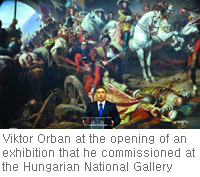
Hungary’s government tightens grip on arts
Right-wing leadership stands accused of controlling the cultural sector for political ends
Already under attack from the European Commission for its policies on banking, the law and the media, Hungary’s national conservative government is now facing a tide of protest from the arts community. The government, led by Viktor Orban, stands accused of systematically replacing key figures in cultural institutions, staging pro-government exhibitions, rethinking permanent museum displays and replacing historic statues to fit its political agenda. “The fact that an authoritarian government wants to control the arts is in itself not surprising,” says the Hungarian economist Janos Kovacs. “But it’s incredible that this is happening in the middle of the European Union without provoking angry reactions in Brussels.”
Since coming to power with a two-thirds majority in 2010, Orban’s Fidesz party has passed more than 350 laws and rushed through a constitution which, the international community argues, endangers Hungarian democracy. Last month, to celebrate the official inauguration of the constitution, Orban opened a government-organised exhibition at the National Gallery. It chronicles 1,000 years of Hungarian history, focusing on sovereign statehood and Christianity (until 16 August). The show includes 15 large state-commissioned canvases depicting important historic events spanning 150 years, including an image of Orban. The event contributed to the decision by the National Gallery’s director, Ferenc Csak, to resign before the show opened. “The government shouldn’t have the power to order exhibitions with such a high political agenda. Museums shouldn’t be getting involved in politics,” says Csak.
There have been other government-instigated changes in personnel at leading institutions. Laszlo Simon, a Fidesz party MP and chairman of the parliamentary cultural and press committee, has become the head of the National Cultural Fund of Hungary—which up until now was a body independent of government, monitored by the culture committee. It is one of the most important organisations that funds Hungarian cultural institutions, including museums, libraries, theatres and archives.
Politically motivated Meanwhile, Gyorgy Szabo, the respected director of Trafo, a leading contemporary art centre, was ousted from his position in January and replaced by the choreographer Yvette Bozsik. The director of Budapest’s Uj Szinhaz theatre, Istvan Marta, was due to be replaced by the extreme right-wing actor Gyorgy Dorner as we went to press. “The government wants to disrupt the fabric of Hungarian culture, by having leading cultural figures disappear and replacing them with their own,” says the art historian Eva Forgacs.
But Laszlo Simon says that the controversies over the appointments are politically motivated: “[They are] mainly generated by the opposition that previously dominated the key positions [in] cultural life in Hungary.”
Orban himself has been quite explicit in his intention to build what he calls “a new, modern, right-wing culture”. He told a party gathering in May 2010: “Hungarian culture must be refreshed with works of art, prizes, celebrations.”
Ferenc Csak has become an outspoken critic of the government’s plans to merge the National Gallery with the Szepmuveszeti Muzeum (Museum of Fine Arts) on 1 March, a major step in creating a museum quarter in Heroes’ Square and beyond. While many support the plan, led by Laszlo Baan, the dynamic director of the Museum of Fine Arts, the project’s speed and lack of consultation is alarming some. “The methods were intolerable; it was just too undemocratic,” says the art historian Peter Gyorgy, who, nevertheless, supports the aims of the scheme. Baan says there are good reasons for the move: “The Hungarian National Gallery features Hungarian art from the early Middle Ages to the present day, and is cut off entirely from the present day—in a more rigid way than anywhere else in the European Union. The objective is to reinstate Hungarian art within a European context.”
The government, meanwhile, stands accused of trying to gloss over uncomfortable details in the country’s history.
Holocaust link deniedA row broke out in March last year over an image of Hungary’s interwar leader, Miklos Horthy, at the Holocaust Memorial Centre.
The state secretary, Andras Levente Gal, said that the picture unjustifiably linked Hungary to the deportation of Jews to Nazi concentration camps and asked that the display be “re-evaluated”. “This kind of historical inaccuracy creates unnecessary tension,” Gal said. His remarks prompted an outcry among some historians and the liberal press. Matters deteriorated when the government relieved Laszlo Harsanyi, the director of the centre, and his chief historical adviser, Judit Molnar, of their positions. “We could not change the permanent exhibition to align with the new political expectations since we regard that as a falsification of history,” Molnar says. In response to their departure, 42 historians and social scientists published an open letter criticising statements in the new constitution.
The government’s proposed restoration of Kossuth Square in front of the Hungarian parliament is causing further controversy. All monuments added since 1945 are due to be removed, and replaced by pre-1944 sculptures. For example, a sculpture of one of the greatest Hungarian poets, Attila Jozsef, erected in 1980, will be replaced by a monument of one-time prime minister Gyula Andrassy.
Peter Gyorgy argues that, in cultural terms, some of these events look worse than they are. “The real issue is that the government doesn’t have the money or time to take care of culture issues,” he says. The artist Miklos Szuts, who spoke at a major anti-government demonstration last month, agrees: “The government can’t control the arts. They can change staff and directors, but it isn’t as important as it seems because there’s such a lack of funds for culture. The government might make symbolic gestures, like the paintings they commissioned, but they don’t have a major effect in reality.”
 Hungary’s government tightens grip on arts
Hungary’s government tightens grip on arts